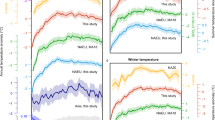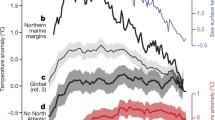Abstract
Palaeoclimate simulations provide an opportunity for climate model evaluation as well as having a potential role in assigning relative likelihood to different ensemble members in probabilistic climate change prediction, supplementing constraints provided by the instrumental record. Here we take some initial steps towards such an approach by performing ensemble experiments with the Hadley Centre HadCM3 model under pre-industrial and mid-Holocene (6,000 years before present) forcing conditions. We examine the changes in both mean tropical climate and El Niño-Southern Oscillation (ENSO) variability, as palaeoclimate records suggest that ENSO amplitude was reduced in the mid-Holocene. Experiments are performed with perturbations to physical parameters in the atmosphere–surface component of the model, and with different implementations of heat and freshwater flux adjustments. Heat flux adjustments are required to stabilise model versions in which perturbations cause a net radiative imbalance. While we find broad agreement between different model versions in terms of changes in mean climate in the mid-Holocene, a detailed and quantitative comparison with the geographically-sparse palaeo-record is limited by systematic model biases. In the simulations without seasonally-varying flux adjustments there are modest reductions in ENSO amplitude of the order of 10–15%, lower than the range of reductions inferred from coral proxy records. We examine the mechanisms for these changes, and discuss the implications for the design of future ensemble experiments to formally quantify uncertainty in climate change predictions using palaeoclimate simulations.












Similar content being viewed by others
References
AchutaRao K, Sperber KR (2002) Simulation of the El Niño southern oscillation: results from the coupled model intercomparison project. Clim Dyn 19:191–209
AchutaRao K, Sperber KR (2006) ENSO simulation in coupled ocean–atmosphere models: are the current models any better? Clim Dyn 27:1–15 DOI 10.1007/s00382-006-0119-7
Berger A (1978) Long-term variations of daily insolation and quaternary climate changes. J Atmos Sci 35:2362–2367
Braconnot P, Joussaume S, Marti O, de Noblet N (1999) Synergistic feedbacks from ocean and vegetation on the African monsoon response to mid-Holocene insolation. Geophys Res Lett 26:2481–2484
Braconnot P, Marti O, Joussaume S, Leclainche Y (2000) Ocean feedback in response to 6 kyr BP insolation. J Clim 13:1537–1553
Brown J, Collins M, Tudhope A (2006) Coupled model simulations of mid-Holocene ENSO and comparisons with coral proxy records. Adv Geosci 6:29–33
Bush A (1999) Assessing the impact of Mid-Holocene insolation on the atmosphere-ocean system. Geophys Res Lett 26:99–102
Cane MA (2005) The evolution of El Niño, past and future. Earth Planet Sci Lett 230:227–240
Chappallaz J, Blunier T, Kints S, Dallenbach A, Barnola J, Schwander J, Raynaud D, Stauffer B (1997) Changes in the atmospheric CH4 gradient between Greenland and Antarctica during the Holocene. J Geophys Res 15987–15999
Clement AC, Seager R, Cane MA (2000) Suppression of El Niño during the mid-Holocene by changes in the Earth’s orbit. Paleoceanography 15:731–737
Clement A, Cane M, Seager R (2001) An orbitally driven tropical source for abrupt climate change. J Clim 14:2369–2375
Collins M (2000) Understanding uncertainties in the response of ENSO to greenhouse warming. Geophys Res Lett 27:3509–3513
Collins M, Tett SFB, Cooper C (2001) The internal climate variability of HadCM3, a version of the Hadley Centre coupled model without flux adjustments. Clim Dyn 17:61–81
Collins M, The CMIP modelling groups (2005) El Niño- or La Niña-like climate change. Clim Dyn 24:89–104
Collins M, Booth BB, Harris GR, Murphy JM, Sexton DMH, Webb MJ (2006) Towards quantifying uncertainty in transient climate change. Clim Dyn 27:127–147 DOI 10.1007/s00382-006-0121-0
Fedorov AV, Philander SG (2000) Is El Niño changing? Science 288:1997–2002
Gagan MK, Ayliffe LK, Hopley D, Cali JA, Mortimer GE, Chappell J, McCulloch MT, Head MJ (1998) Temperature and surface-ocean water balance of the mid-Holocene tropical western Pacific. Science 279:1014–1018
Gagan MK, Hendy EJ, Haberle SG, Hantoro WS (2004) Post-glacial evolution of the Indo-Pacific Warm Pool. Quat Int 118–119:127–143
Ganopolski A, Kubatzki C, Claussen M, Brovkin V, Petoukhov V (1998) The influence of vegetation-atmosphere-ocean interaction on climate during the mid-Holocene. Science 280:1916–1919
Gordon C, Cooper C, Senior CA, Banks H, Gregory JM, Johns TC, Mitchell JFB, Wood RA (2000) The simulation of SST, sea ice extent and ocean heat transports in a version of the Hadley Centre coupled model without flux adjustments. Clim Dyn 16:147–168
Guilyardi E (2006) El Niño–mean state–seasonal cycle interactions in a multi-model ensemble. Clim Dyn 26:329–348 DOI 10.1007/s00382-005-0084-6
Harrison SP, Jolly D, Laarif F, Abe-Ouchi A, Dong B, Herterich K, Hewitt C, Joussaume S, Kutzbach JE, Mitchell J, de Noblet N, Valdes P (1998) Intercomparison of simulated global vegetation distributions in response to 6 kyr BP orbital forcing. J Clim 11:2721–2742
Haug GH, Hughen KA, Sigman DM, Peterson LC, Rohl U (2001) Southward migration of the Intertropical Convergence Zone through the Holocene. Science 293:1304–1307
Hewitt CD, Mitchell JFB (1998) A fully coupled GCM simulation of the climate of the mid-Holocene. Geophys Res Lett 25:361–364
Indermuhle A, Stocker TF, Joos F, Fischer H, Smith HJ, Wahlen M, Deck B, Mastroianni D, Tschumi J, Blunier T, Meyer R, Stauffer B (1999) Holocene carbon-cycle dynamics based on CO2 trapped in ice at Taylor Dome, Antarctica. Nature 398:121–126
Inness PM, Slingo JM, Guilyardi E, Cole J. (2003) Simulation of the Madden-Julian Oscillation in a coupled general circulation model. Part II: the role of the basic state. J Clim 16:365–382
Joussaume S, Taylor KE, Braconnot P, Mitchell JFB, Kutzbach JE, Harrison SP, Prentice IC, Broccoli AJ, Abe-Ouchi A, Bartlein PJ, Bonfils C, Dong B, Guiot J, Herterich K, Hewitt CD, Jolly D, Kim JW, Kislov A, Kitoh A, Loutre MF, Masson V, McAvaney B, McFarlane N, de Noblet N, Peltier WR, Peterschmitt JY, Pollard D, Rind D, Royer JF, Schlesinger ME, Syktus J, Thompson S, Valdes P, Vettorett G, Webb RS, Wyputta U (1999) Monsoon changes for 6000 years ago: results of 18 simulations from the Paleoclimate Modeling Intercomparison Project (PMIP). Geophys Res Lett 26(7):859–862
Kitoh A, Murakami S (2002) Tropical Pacific climate at the mid-Holocene and the Last Glacial Maximum simulated by a coupled ocean-atmosphere general circulation model. Paleoceanography 17:1047 DOI 10.1029/2001PA000724
Koutavas A, Lynch-Stieglitz J, Marchitto TM, Sachs JP (2002) El Niño-like pattern in Ice Age tropical Pacific sea surface temperature. Science 297:226–230
Knutti R, Meehl GA, Allen MR, Stainforth DA (2006) Constraining climate sensitivity from the seasonal cycle in surface temperature. J Clim 19:4224–4233
Lea DW, Pak DK, Belanger CL, Spero HJ, Hall MA, Shackleton NJ (2006) Paleoclimate history of Galápagos surface waters over the last 135,000 yr. Quat Sci Rev 25:1152–1167
Latif M, Sperber K, Arblaster J, Braconnot P, Chen D, Colman A, Cubasch U, Cooper C, Delecluse P, DeWitt D, Fairhead L, Flato G, Hogan T, Ji M, Kimoto M, Kitoh A, Knutson T, Le Treut H, Li T, Manabe S, Marti O, Mechoso C, Meehl G, Power S, Roeckner E, Sirven J, Terray L, Vintzileos A, Voss R, Wang B, Washington W, Yoshikawa I, Yu J, Zebiak S (2001) ENSIP: the El Niño simulation intercomparison project. Clim Dyn 18:255–276
Liu Z, Kutzbach J, Wu L (2000) Modeling climate shift of El Niño variability in the Holocene. Geophys Res Lett 27:2265–2268
Liu Z, Otto-Bliesner B, Kutzbach J, Li L, Shields C (2003) Coupled model simulation of the evolution of global monsoons in the Holocene. J Clim 16:2472–2490
Liu Z, Harrison SP, Kutzbach J, Otto-Bliesner B (2004) Global monsoons in the mid-Holocene and oceanic feedback. Clim Dyn 22:157–182
McGregor HV, Gagan MK (2004) Western Pacific coral δ18O records of anomalous Holocene variability in the El Niño-Southern Oscillation. Geophys Res Lett L11204 DOI 10.1029/2004GL019972
Meehl GA, Gent PR, Arblaster JM, Otto-Bliesner BL, Brady EC, Craig A (2001) Factors that affect the amplitude of El Niño in global coupled climate models. Clim Dyn 17:515–526
Merryfield WJ (2006) Changes to ENSO under CO2 doubling in a multi-model ensemble. J Clim 19:4009:4027
Moy CM, Seltzer GO, Rodbell DT, Anderson DM (2002) Variability of El Niño/Southern Oscillation activity at millennial timescales during the Holocene epoch. Nature 420:162–165
Murphy J, Sexton D, Barnett D, Jones G, Webb M, Collins M, Stainforth D (2004) Quantification of modelling uncertainties in a large ensemble of climate change simulations. Nature 430:768–772
Otto-Bliesner B, Brady E, Shin S, Liu Z, Shields C (2003) Modeling El Niño and its tropical teleconnections during the last glacial-interglacial cycle. Geophys Res Lett 30 DOI 10.1029/2003GL018553
Piani C, Frame DJ, Stainforth DA, Allen MR (2005) Constraints on climate change from a multi-thousand member ensemble of simulations. Geophys Res Lett 32:L23825 DOI 10.1029/2005GL024452
Pope VD, Gallani ML, Rowntree PR, Stratton RA (2000) The impact of new physical parametrizations in the Hadley Centre climate model–HadAM3. Clim Dyn 16:123–146
Rayner NA, Parker DE, Horton EB, Folland CK, Alexander LV, Rowell DP, Kent EC, Kaplan A (2003) Global analyses of sea surface temperature, sea ice, and night marine air temperature since the late nineteenth century. J Geophys Res 108:4407 DOI 10.1029/2002JD002670
Rodbell DT, Seltzer GO, Anderson DM, Abbott MB, Enfield DB, Newman JH (1999) An ∼15,000 year record of El Niño-driven alluviation in southwestern Ecuador. Science 283:516–520
Sandweiss DH, Richardson JB, Reitz EJ, Rollins HB, Maasch KA (1996) Geoarchaeological evidence from Peru for a 5000 year B.P. onset of El Niño. Science 273:1531–1533
Spencer H, Sutton R, Slingo JM (2007) El Niño in a coupled climate model: sensitivity to changes in mean state induced by heat flux and wind stress corrections. J Clim (in press)
Stott L, Cannariato K, Thunell R, Haug GH, Koutavas A, Lund S (2004): Decline of surface temperature and salinity in the western tropical Pacific Ocean in the Holocene epoch. Nature 431:56–59
Tebaldi C, Smith RL, Nychka D, Mearns LO (2005) Quantifying uncertainty in projections of regional climate change: A Bayesian approach to the analysis of multi-model ensembles. J Clim 18:1524–1540
Toniazzo T (2006) A study of the sensitivity of ENSO to the mean climate. Adv Geosci 6:111–118
Toniazzo T, Collins M, Brown J (2007) The variation of ENSO characteristics associated with atmospheric parameter perturbations in a coupled model. Clim Dyn (submitted)
Tudhope AW, Chilcott CP, McCulloch MT, Cook ER, Chappell J, Ellam RM, Lea DW, Lough JM, Shimmield GB (2001) Variability in the El Niño-Southern Oscillation through a glacial-interglacial cycle. Science 291:1511–1517
Turner AG, Inness PM, Slingo JM (2005) The role of the basic state in the ENSO-monsoon relationship and implications for predictability. Quart J R Meteorol Soc 131:781–804
Tziperman E, Zebiak SE, Cane MA (1997) Mechanisms of seasonal–ENSO interaction. J Atmos Sci 54:61–71
van Oldenborgh GJ, Philip S, Collins M (2005) El Niño in a changing climate: a multi-model study. Ocean Sci Discuss 2:267–298
Wang C, Picaut J (2004) Understanding ENSO physics: a review. In: Wang C, Xie S-P, Carton JA (eds) Earth’s climate: the ocean-atmosphere interaction, geophysical monograph series, AGU, Washington, pp 21–48
Webb MJ, Senior CA, Sexton DMH, Ingram WJ, Williams KD, Ringer MA, McAvaney BJ, Colman R, Soden BJ, Gudgel R, Knutson T, Emori S, Ogura T, Tsushima Y, Andronova N, Li B, Musat I, Bony S, Taylor KE (2006) On the contribution of local feedback mechanisms to the range of climate sensitivity in two GCM ensembles. Clim Dyn 27:17–38
Webster P, Yang S (1992) Monsoon and ENSO: selectively interacting systems. Quart J R Meterol Soc 118:877–926
Zebiak SE, Cane MA (1987) A model El Niño/Southern Oscillation. Month Weather Rev 115:2262–2278
Zhao Y, Braconnot P, Marti O, Harrison SP, Hewitt C, Kitoh A, Liu Z, Mikolajewicz U, Otto-Bliesner B, Weber SL (2005) A multi-model analysis of the role of the ocean on the African and Indian monsoon during the mid-Holocene. Clim Dyn 25:777–800
Acknowledgments
We thank Paul Valdes for assistance with the model set-up for the mid-Holocene simulations. Andy Turner, Hilary Spencer, Matthieu Lengaigne and Eric Guilyardi contributed useful comments on aspects of this work. The comments of four anonymous reviewers also greatly improved this manuscript. This study was funded by the Natural Environment Research Council RAPID programme.
Author information
Authors and Affiliations
Corresponding author
Rights and permissions
About this article
Cite this article
Brown, J., Collins, M., Tudhope, A.W. et al. Modelling mid-Holocene tropical climate and ENSO variability: towards constraining predictions of future change with palaeo-data. Clim Dyn 30, 19–36 (2008). https://doi.org/10.1007/s00382-007-0270-9
Received:
Accepted:
Published:
Issue Date:
DOI: https://doi.org/10.1007/s00382-007-0270-9




